Verdict
The Bose Smart Ultra Soundbar is a one-box Atmos soundbar that entertains with a wide, tall, and spacious sound. Its direct and punchy performance brings power to films and TV, though it does on occasion misbehave with its strange audio dropouts.
Pros
- Punchy, firm delivery
- Spacious sound
- Premium looks
- Good range of wireless connectivity
Cons
- No DTS support
- Odd audio drop outs
-
Bose TrueSpaceAnalyses non-Atmos tracks and upscales them to immersive audio -
AI Dialogue modeEnhances dialogue for better clarity -
Bose SimpleSyncConnect your Bose headphones to the soundbar for private listening session
Introduction
The single-box soundbar has become a popular option for customers to get a big, immersive sound into their living rooms without taking up too much space. Joining this long list is the Bose Smart Ultra Soundbar.
The argument for a single-box immersive bar is that it’s convenient, saving on space and clutter, though it’s not exactly “immersive” without rear speakers and an additional subwoofer so there is a trade-off to be made.
Is it worth making that trade-off with the Bose Smart Ultra Soundbar? With Bose’s pedigree in the audio field, it has plenty of potential, but there’s also plenty of competition from the likes of Sony, Sonos, and Bowers & Wilkins.
Design
- Premium looks
- Small LED bar
- Choice of black or white colours
The Bose Smart Ultra Soundbar doesn’t look all that different from the Smart Soundbar 900. As per usual from Bose, the flagship model is all sleek contoured lines, metal grilles, and glass surfaces. It looks every inch a premium bar.
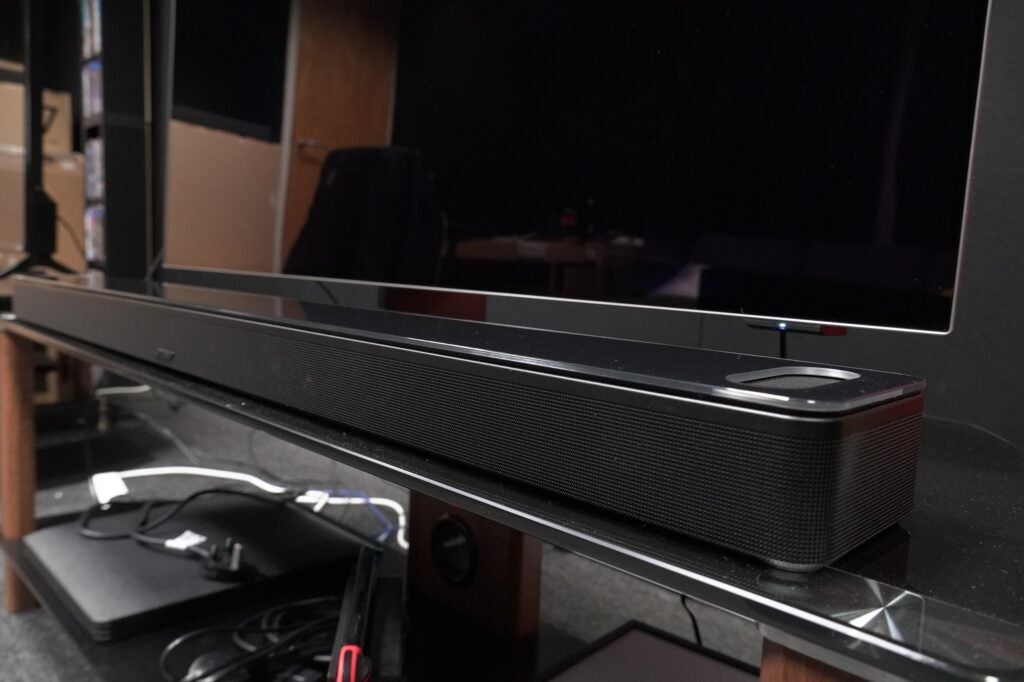
Though if you get up close and touch the soundbar, you’ll want to give the white glove treatment as it’s a magnet for smudges and fingerprints.
Available in arctic white and black finishes (the former I’m presuming is less noticeable with smudges), the bar is 1045mm wide, 58mm tall and 107mm deep. It should be able to slide beneath a TV without complaint.
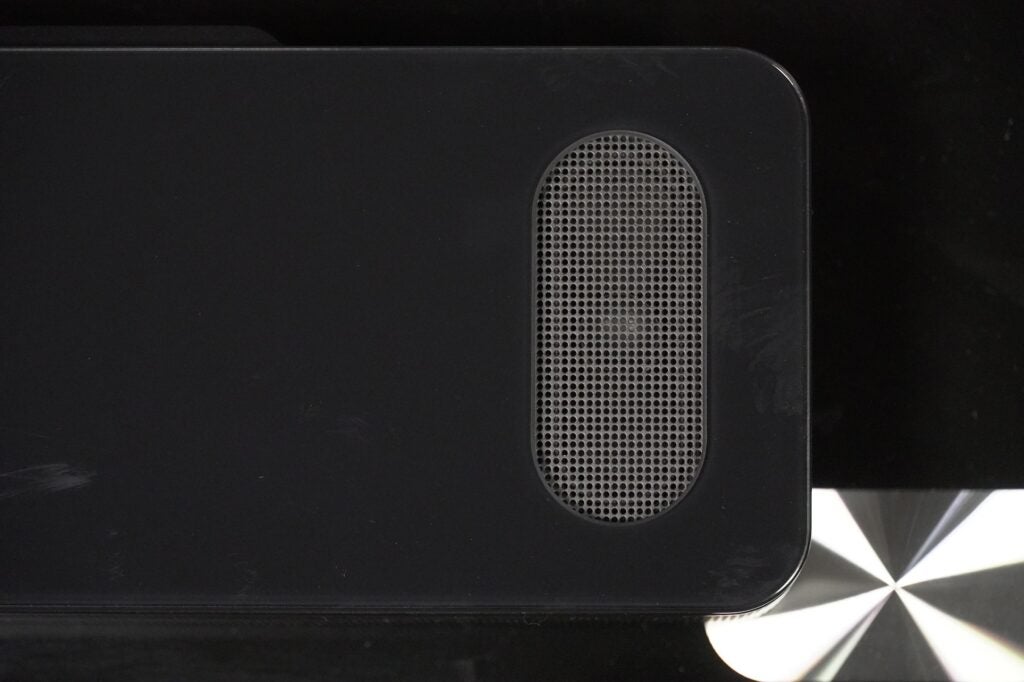
At either end are two grilles that cover the upfiring drivers. The silver décor is a nice contrast to the blue-ish finish of the speaker itself.
In a recessed section around the rear are the connections, on top are a couple of touch controls (microphone and power), while above the grille on the front left is the status bar that flashes a variety of colours (but mainly white or amber). It can be a little difficult to spot given how slim the LED is above the grille.
Let’s not forget the remote control, which is tiny and could possibly get lost between the spaces of your sofa if you’re not too careful. It has all the buttons you’ll need to operate, keeping things very simple, but strangely feels out of place with the premium stylings of the soundbar. In terms of handling it and feedback from buttons, it’s rather plain.
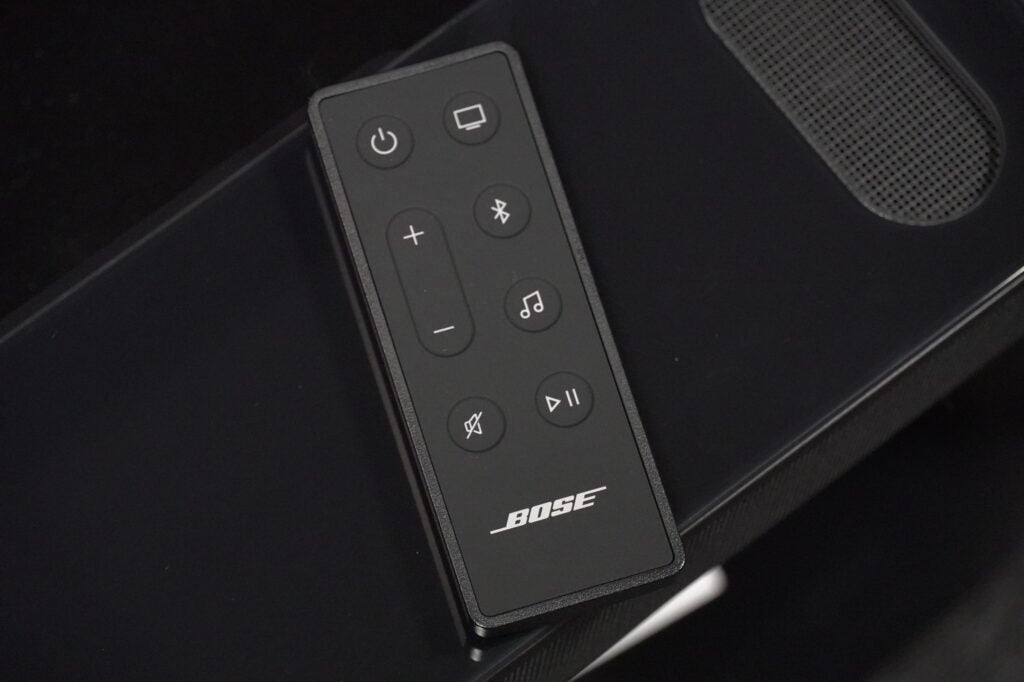
Features
- No native DTS support
- Bose Music app
- AI Dialogue feature
Given Dolby is an ever-present across video streaming services, it’s no surprise the Bose Smart Ultra Soundbar is a Dolby fanboy (Atmos along with Dolby Digital, TrueHD, and Digital Plus). It’s disappointing there’s no native DTS representation. Any DTS signals appear as LPCM tracks in the Bose Music app.
Connectivity to a TV is through eARC (there are no HDMI inputs) and optical input, while there is a USB but it’s service only. The Bose Smart Ultra Soundbar keeps this area simple, but it does mean home cinema fans who might have need of plugging their sources into a soundbar should have to look at alternatives like the Sony HT-A5000.
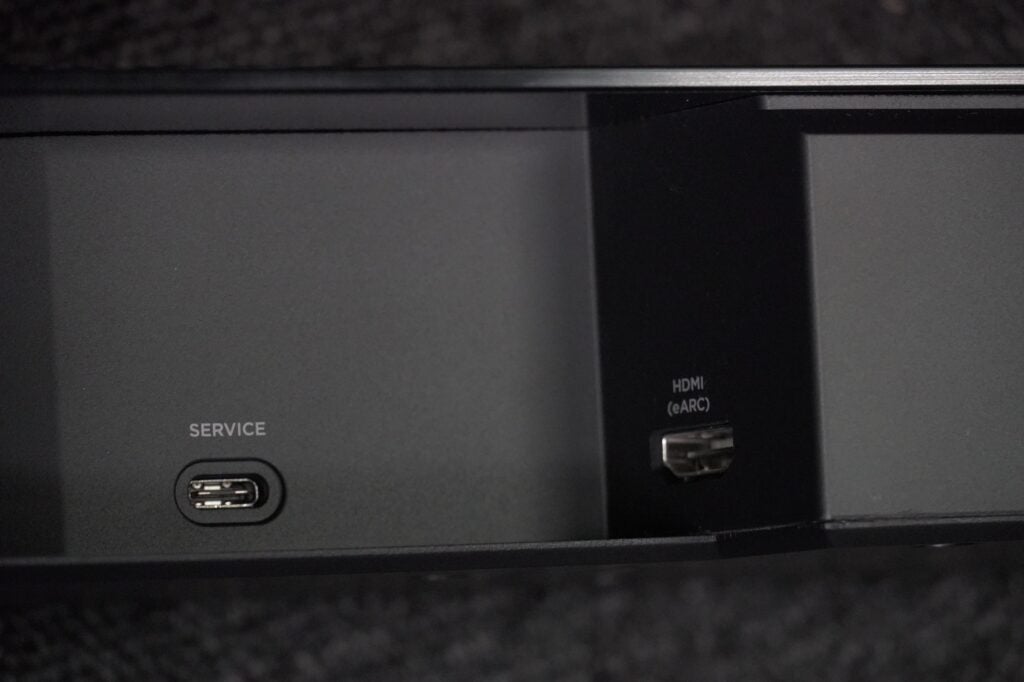
Wireless connectivity includes Wi-Fi (naturally), AirPlay 2, Chromecast, Spotify Connect and Bluetooth 5 (SBC, AAC). You can control audio playback through the Bose Music app.
The Bose Music app services all of Bose’s wireless products. Its clean look and simple means of operation and navigation are all positives – the problem is that it’s not the most stable. It’ll say it’s installing an update that goes on for hours if not days, and it has a tendency to misbehave, which I’ll get into with the ‘Sound Quality’ section.
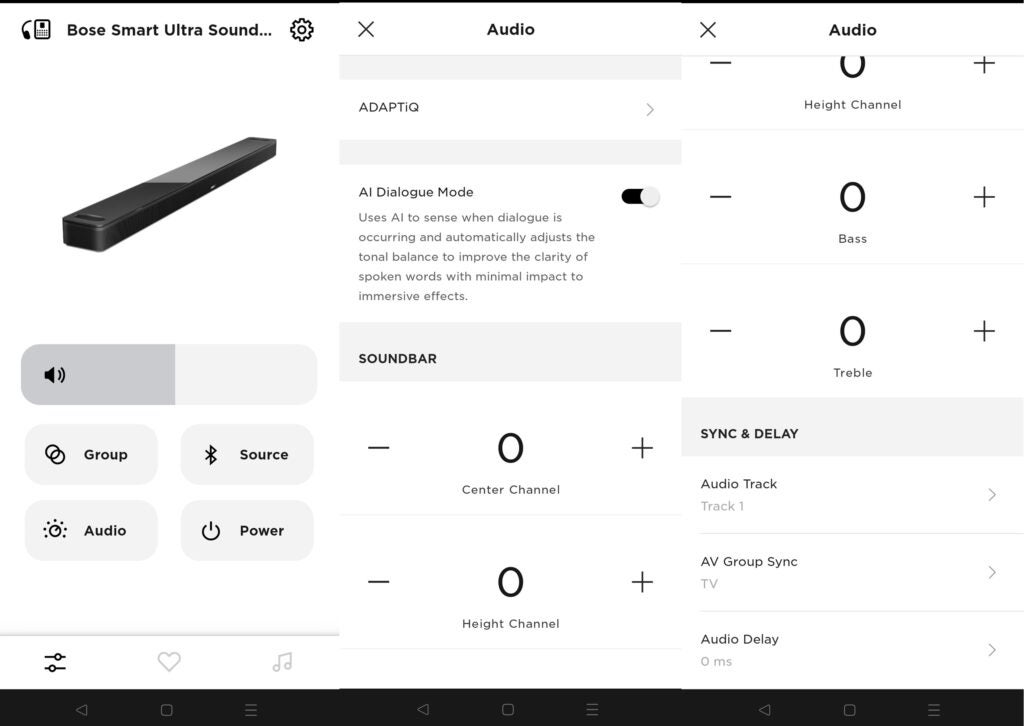
There’s an AI Dialogue feature that provides an added focus on what’s being said, and within the app you can create music presets, as well as group together other Wi-Fi enabled products. For instance, you could add the Bass Module 700 (£799 / $849) and Surround Speakers 700 (£549 / $599) for an immersive experience.
If you’ve got Bose headphones they can be connected directly to the soundbar for a private listening session through Bose’s SimpleSync technology. The Bose Voice4Video technology can, apparently, allow Alexa to take control of not just the soundbar, but your TV, cable, and satellite box. She can even switch between the inputs if you ask her nicely.
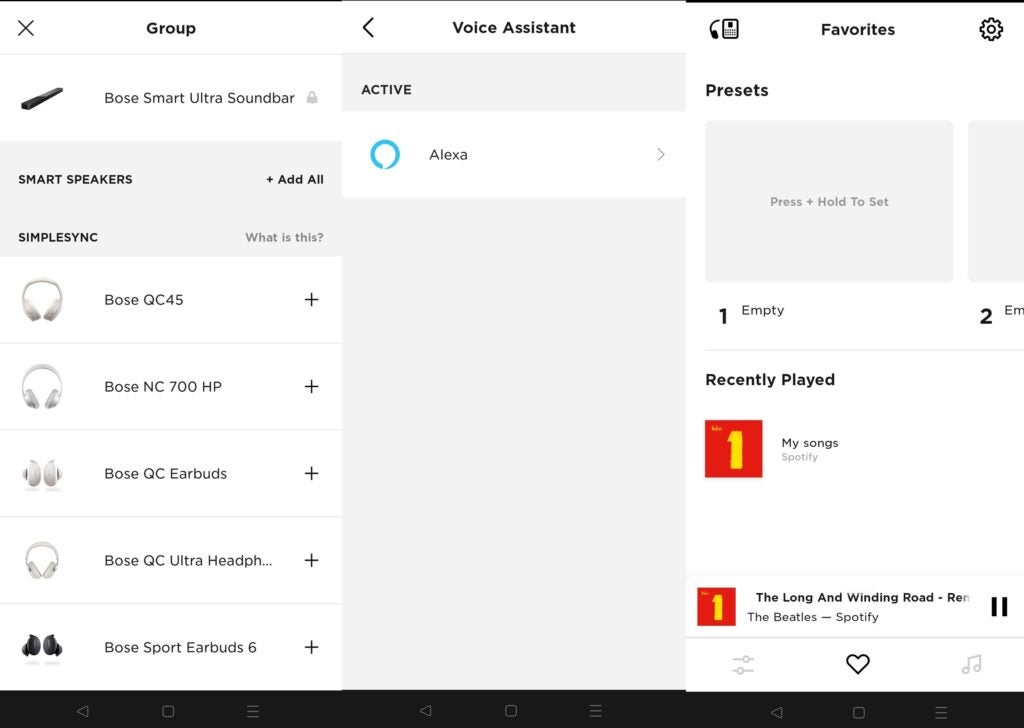
Alexa is built in and she’s responsive to commands, though if you’re playing audio loud I’ve found you do have to raise your voice for her to pick up your voice. There’s ‘Works With’ Google support for those who have products within that smart ecosystem.
The AdaptIQ is where you can perform your best “to me, my X-Men!” impression of Charles Xavier with a headset that you put on your head and connect to the bar through a wired connection. If you don’t mind looking a little silly and shuffling around a room, it’ll measure the space the bar is in and calibrate accordingly.
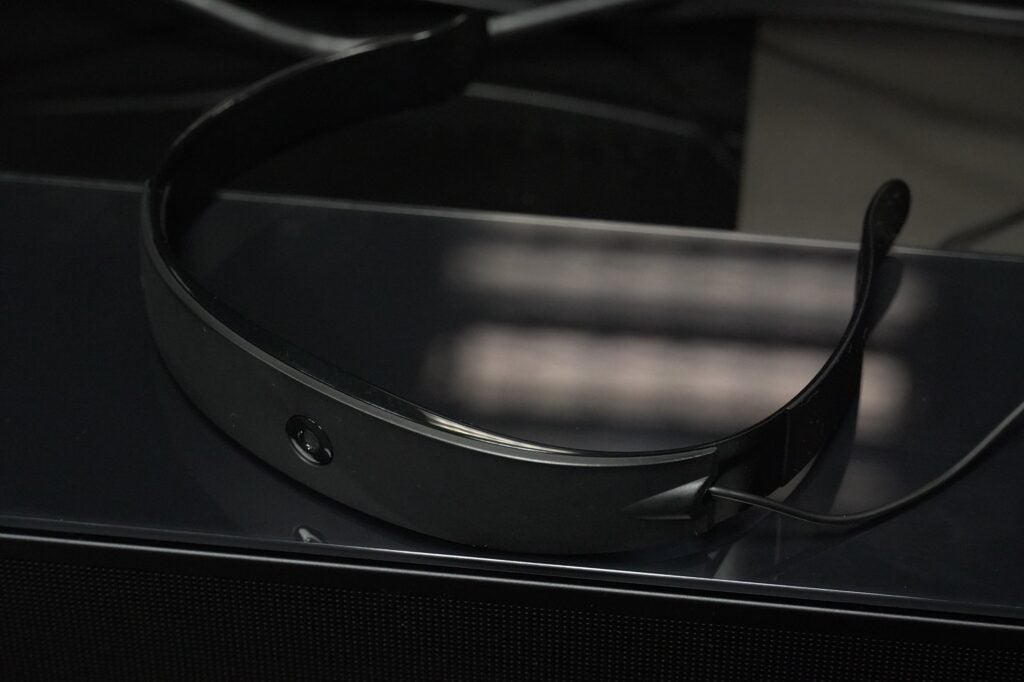
Sound Quality
- Tall and wide sound
- Punchy bass
- Firm handle on dialogue
The Bose Smart Ultra Soundbar is up against distinguished competition, but holds its own with a robust and aggressive performance, with bass that belies its slim proportions.
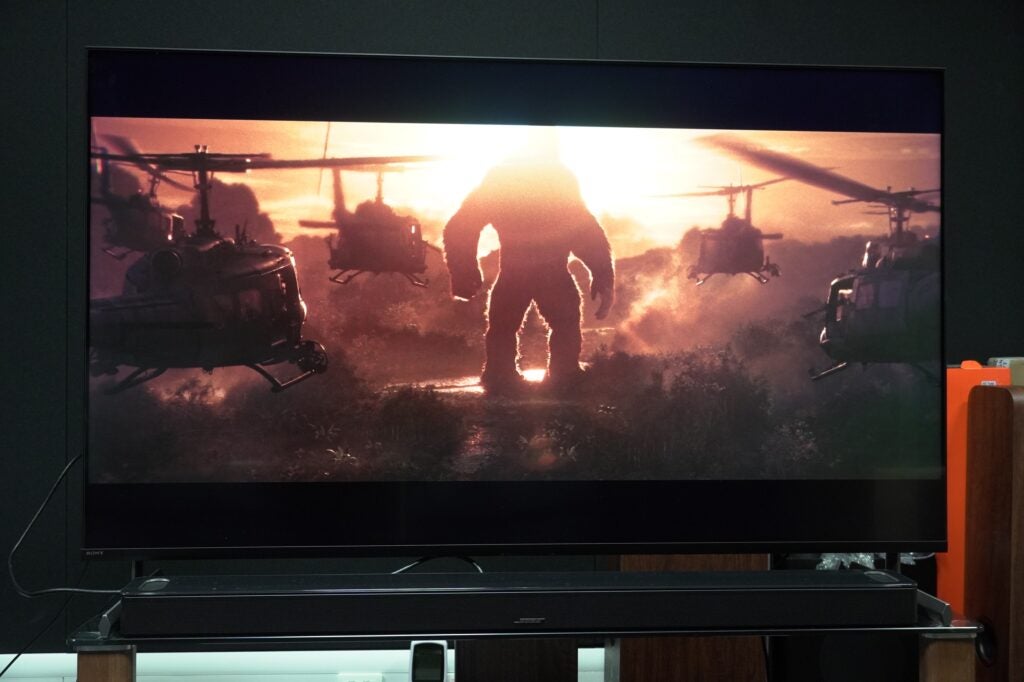
Starting off with Kong: Skull Island (Atmos) and right from the opening credits, the Smart Ultra Soundbar forges a firm, punchy, and aggressive-sounding bass performance. The Bose is direct in how it reproduces dialogue, with a neutral delivery that avoids sounding crisp but maintains good levels of faithfulness.
A favourite test of mine is the ‘Gom Jabbar’ scene from Dune (Atmos) and the Bose skates through with excellent reproduction of dialogue, even without the use of the AI Dialogue assist, though some dialogue can sound a little thinner with the AI Dialogue on.
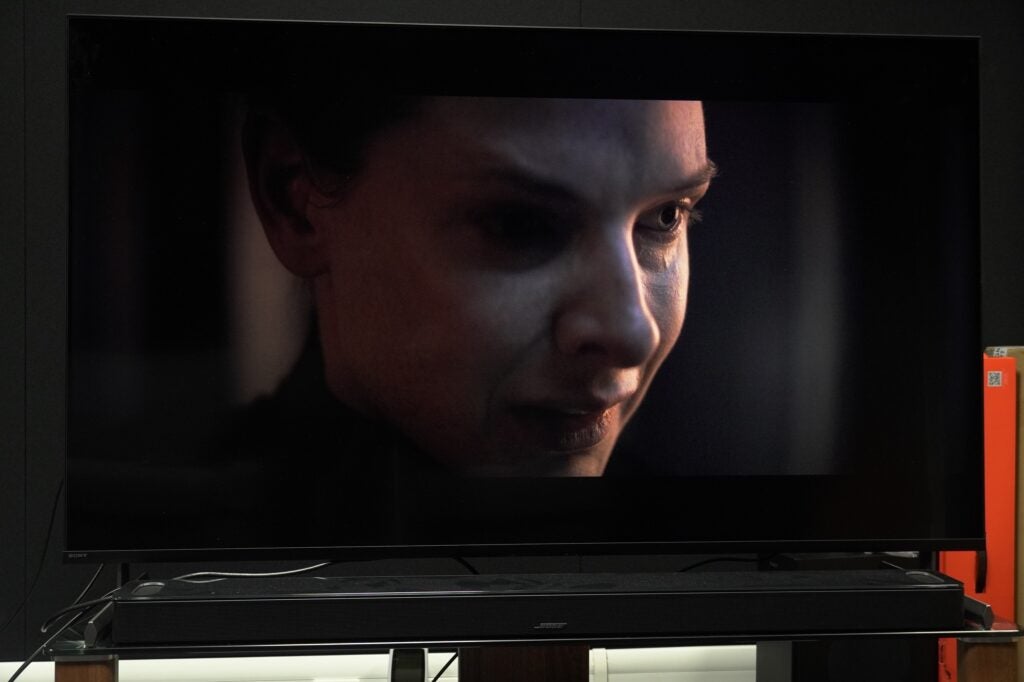
The soundstage produced is quite tall in terms of height and wide enough that it surpasses the boundaries of the TV screen – the music riffs in Skull Island often float just either side of the screen, adding to the ambience of the soundtrack.
There is also depth with effects placed near and far combining to good effect, with some astute panning and tracking of sounds across the screen, while the soundbar takes a sharp but not too sharp presence with high frequency sounds. I like the tonal balance that it offers across the frequency range – punchy, firm, and neutral without sounding overly crisp.
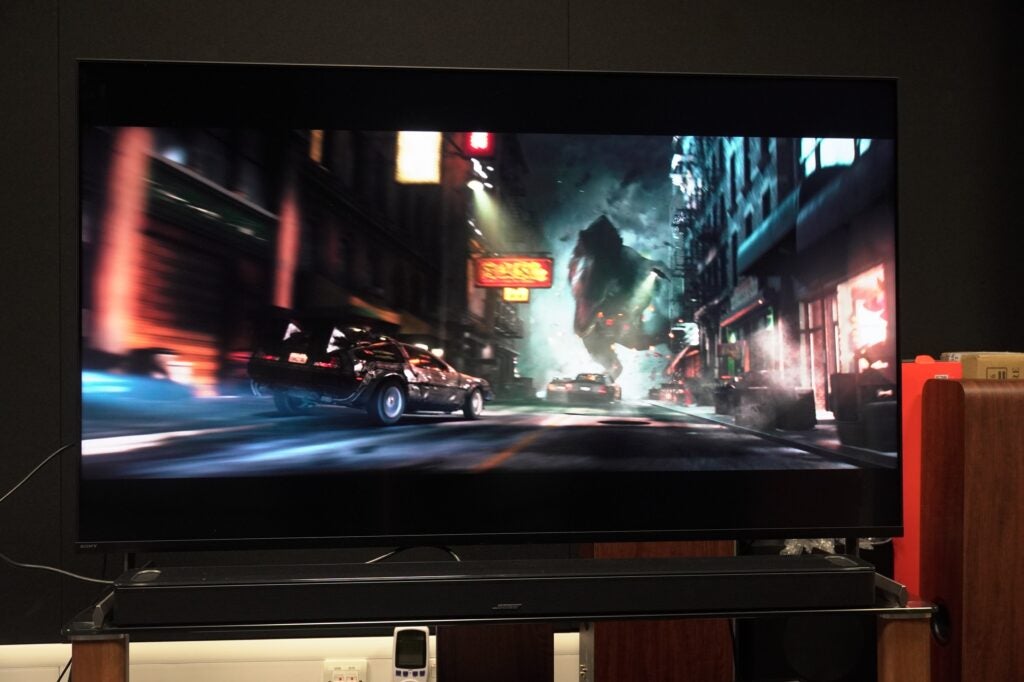
The soundbar doesn’t fire sounds out towards the seating position, but to be fair, not many Atmos bars do. And as the Smart Ultra Soundbar is just one bar, subwoofers and rear speakers are extra for the full Atmos surround sound effect.
Nevertheless bass is surprisingly good for a one-box soundbar system. I’d admit there’s not much depth that you’d get from a separate subwoofer, but there’s depth and firmness to low frequencies when the depth charges are flung from the helicopter in Skull Island. Giving Oppenheimer (DTS) a test run, there’s punchiness to an explosion of a boat but the Bose meets its limits with Nolan’s Oscar-winning film as it lacks enough depth and power to really make you feel as if the explosion rips from the screen.
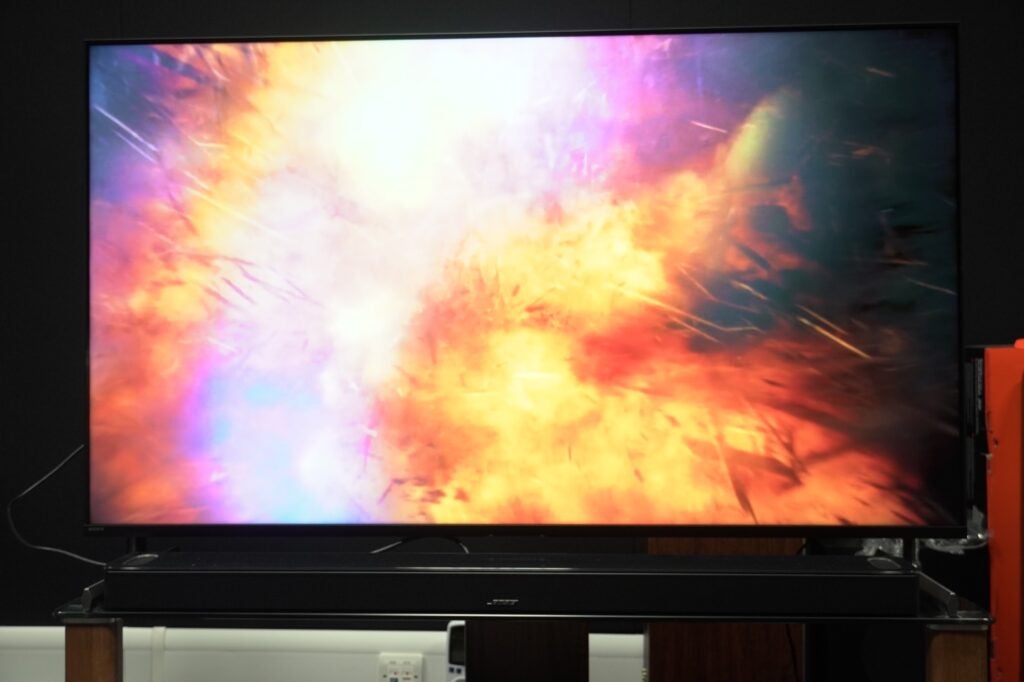
At least with Blade Runner 2049 (Atmos) there’s no distortion in the bass-heavy opening credits that I can hear. Again, while it’s limited, there’s enough heft to give the room a minor shake, while with Mission Impossible: Dead Reckoning (Atmos) there’s a nice thrust and power to the soundtrack that gives requisite force to action scenes. It won’t replace a subwoofer, but easily outperforms a TV.
And sticking with Dead Reckoning, the Bose achieves a nice balance between the various effects in the Rome chase sequence, highlighting what’s important in terms of the action and excitement without it becoming an audio soup.
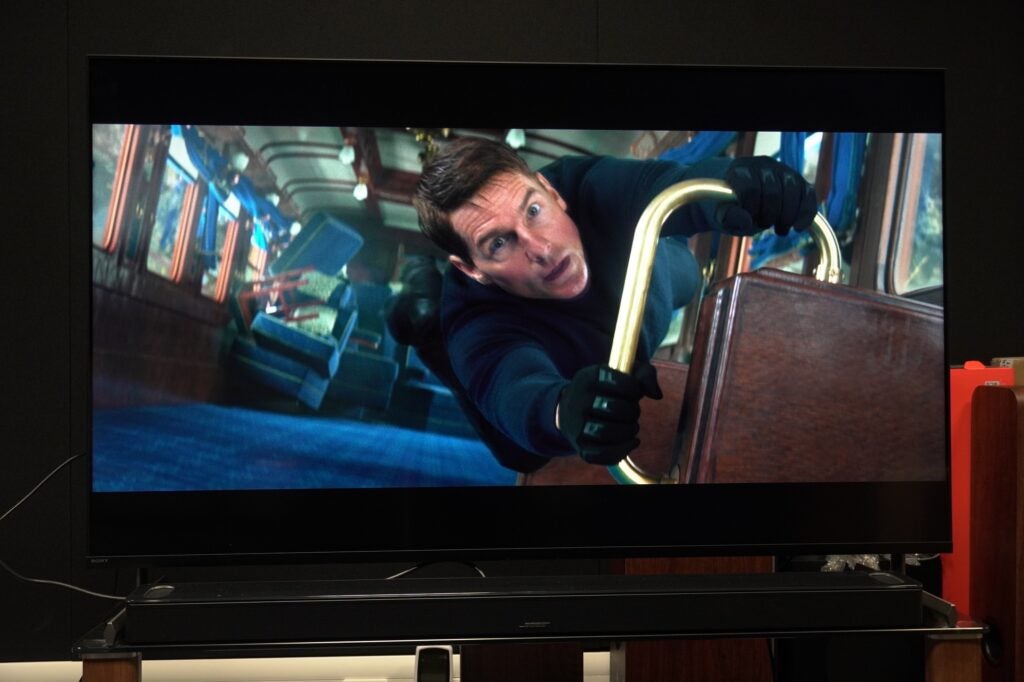
From the sound of the police tank, to gunshots, glass smashing, the squeal of tyres on Rome’s cobble surface to Lorne Balfe’s score; it’s all brought together cohesively, and among this hectic action there’s still a bubble maintained for dialogue. There’s a lot on the Bose’s plate in this scene and it manages it well.
It’s also capable of a fluid sense of dynamism, the difference between loud and quiet is stated clearly (and dramatically) in a scene where Gabriel interrogates an Italian police officer.
What’s most disappointing about the performance is when it’s not working. The Bose Smart Ultra Soundbar had a tendency to misbehave with sound cutting out randomly – sometimes just by rewinding or fast-forwarding. Turning the bar on and off at the plug rectified it, but not always. Changing the HDMI settings on the bar didn’t stop it from occurring either.

The music performance from the Bose is surprisingly warm given what I said about its neutrality with films and TV. It’s an engaging presentation over Wi-Fi, with a strong emphasis on bass in The Beatles’ Long and Winding Road.
With Bluetooth there’s less an emphasis on bass and a tad more midrange clarity, but to my ears the Bose sounds consistent whether over Wi-Fi or Bluetooth.
Latest deals
Should you buy it?
For its punchy, firm delivery
There’s power and attack to the Bose’s delivery that makes it a good match for action and horror films.
If you want a reliable bar
The Smart Ultra Soundbar’s audio has a tendency to drop out. It might just be this sample but Bose’s soundbars have a history of sketchy performances.
Final Thoughts
Aside from its tendency to misbehave, the Bose Smart Ultra Soundbar is a strong contender for those who want Dolby Atmos audio but don’t have the room for a full home cinema setup.
It suffers from a front-heavy soundstage like all one-box Atmos bars, but its tall and wide sound is bigger than you’d get from a stereo bar, and there’s plenty of smarts and added features to take advantage of, especially if you’ve got Bose products in the home.
Without DTS support or a HDMI input, it’s not built for home cinema enthusiasts. At this price there’s competition from the likes of Sony, Bowers & Wilkins and Sonos; and while I’d say the Bose is better than them, it competes well among this distinguished bunch. Check out my Best Soundbar guide for more options.
How we test
We test every soundbar we review thoroughly over an extended period of time. We use industry standard tests to compare features properly. We’ll always tell you what we find. We never, ever, accept money to review a product.
Find out more about how we test in our ethics policy.
Tested with real world use
Tested across several months
FAQs
You can add a subwoofer to the Smart Ultra Soundbar in the Bass Module 700. That costs £700 or $849, which is almost as much as the soundbar itself.
Verdict
The Bose Smart Ultra Soundbar is a one-box Atmos soundbar that entertains with a wide, tall, and spacious sound. Its direct and punchy performance brings power to films and TV, though it does on occasion misbehave with its strange audio dropouts.
Pros
- Punchy, firm delivery
- Spacious sound
- Premium looks
- Good range of wireless connectivity
Cons
- No DTS support
- Odd audio drop outs
-
Bose TrueSpaceAnalyses non-Atmos tracks and upscales them to immersive audio -
AI Dialogue modeEnhances dialogue for better clarity -
Bose SimpleSyncConnect your Bose headphones to the soundbar for private listening session
Introduction
The single-box soundbar has become a popular option for customers to get a big, immersive sound into their living rooms without taking up too much space. Joining this long list is the Bose Smart Ultra Soundbar.
The argument for a single-box immersive bar is that it’s convenient, saving on space and clutter, though it’s not exactly “immersive” without rear speakers and an additional subwoofer so there is a trade-off to be made.
Is it worth making that trade-off with the Bose Smart Ultra Soundbar? With Bose’s pedigree in the audio field, it has plenty of potential, but there’s also plenty of competition from the likes of Sony, Sonos, and Bowers & Wilkins.
Design
- Premium looks
- Small LED bar
- Choice of black or white colours
The Bose Smart Ultra Soundbar doesn’t look all that different from the Smart Soundbar 900. As per usual from Bose, the flagship model is all sleek contoured lines, metal grilles, and glass surfaces. It looks every inch a premium bar.

Though if you get up close and touch the soundbar, you’ll want to give the white glove treatment as it’s a magnet for smudges and fingerprints.
Available in arctic white and black finishes (the former I’m presuming is less noticeable with smudges), the bar is 1045mm wide, 58mm tall and 107mm deep. It should be able to slide beneath a TV without complaint.

At either end are two grilles that cover the upfiring drivers. The silver décor is a nice contrast to the blue-ish finish of the speaker itself.
In a recessed section around the rear are the connections, on top are a couple of touch controls (microphone and power), while above the grille on the front left is the status bar that flashes a variety of colours (but mainly white or amber). It can be a little difficult to spot given how slim the LED is above the grille.
Let’s not forget the remote control, which is tiny and could possibly get lost between the spaces of your sofa if you’re not too careful. It has all the buttons you’ll need to operate, keeping things very simple, but strangely feels out of place with the premium stylings of the soundbar. In terms of handling it and feedback from buttons, it’s rather plain.

Features
- No native DTS support
- Bose Music app
- AI Dialogue feature
Given Dolby is an ever-present across video streaming services, it’s no surprise the Bose Smart Ultra Soundbar is a Dolby fanboy (Atmos along with Dolby Digital, TrueHD, and Digital Plus). It’s disappointing there’s no native DTS representation. Any DTS signals appear as LPCM tracks in the Bose Music app.
Connectivity to a TV is through eARC (there are no HDMI inputs) and optical input, while there is a USB but it’s service only. The Bose Smart Ultra Soundbar keeps this area simple, but it does mean home cinema fans who might have need of plugging their sources into a soundbar should have to look at alternatives like the Sony HT-A5000.

Wireless connectivity includes Wi-Fi (naturally), AirPlay 2, Chromecast, Spotify Connect and Bluetooth 5 (SBC, AAC). You can control audio playback through the Bose Music app.
The Bose Music app services all of Bose’s wireless products. Its clean look and simple means of operation and navigation are all positives – the problem is that it’s not the most stable. It’ll say it’s installing an update that goes on for hours if not days, and it has a tendency to misbehave, which I’ll get into with the ‘Sound Quality’ section.

There’s an AI Dialogue feature that provides an added focus on what’s being said, and within the app you can create music presets, as well as group together other Wi-Fi enabled products. For instance, you could add the Bass Module 700 (£799 / $849) and Surround Speakers 700 (£549 / $599) for an immersive experience.
If you’ve got Bose headphones they can be connected directly to the soundbar for a private listening session through Bose’s SimpleSync technology. The Bose Voice4Video technology can, apparently, allow Alexa to take control of not just the soundbar, but your TV, cable, and satellite box. She can even switch between the inputs if you ask her nicely.

Alexa is built in and she’s responsive to commands, though if you’re playing audio loud I’ve found you do have to raise your voice for her to pick up your voice. There’s ‘Works With’ Google support for those who have products within that smart ecosystem.
The AdaptIQ is where you can perform your best “to me, my X-Men!” impression of Charles Xavier with a headset that you put on your head and connect to the bar through a wired connection. If you don’t mind looking a little silly and shuffling around a room, it’ll measure the space the bar is in and calibrate accordingly.

Sound Quality
- Tall and wide sound
- Punchy bass
- Firm handle on dialogue
The Bose Smart Ultra Soundbar is up against distinguished competition, but holds its own with a robust and aggressive performance, with bass that belies its slim proportions.

Starting off with Kong: Skull Island (Atmos) and right from the opening credits, the Smart Ultra Soundbar forges a firm, punchy, and aggressive-sounding bass performance. The Bose is direct in how it reproduces dialogue, with a neutral delivery that avoids sounding crisp but maintains good levels of faithfulness.
A favourite test of mine is the ‘Gom Jabbar’ scene from Dune (Atmos) and the Bose skates through with excellent reproduction of dialogue, even without the use of the AI Dialogue assist, though some dialogue can sound a little thinner with the AI Dialogue on.

The soundstage produced is quite tall in terms of height and wide enough that it surpasses the boundaries of the TV screen – the music riffs in Skull Island often float just either side of the screen, adding to the ambience of the soundtrack.
There is also depth with effects placed near and far combining to good effect, with some astute panning and tracking of sounds across the screen, while the soundbar takes a sharp but not too sharp presence with high frequency sounds. I like the tonal balance that it offers across the frequency range – punchy, firm, and neutral without sounding overly crisp.

The soundbar doesn’t fire sounds out towards the seating position, but to be fair, not many Atmos bars do. And as the Smart Ultra Soundbar is just one bar, subwoofers and rear speakers are extra for the full Atmos surround sound effect.
Nevertheless bass is surprisingly good for a one-box soundbar system. I’d admit there’s not much depth that you’d get from a separate subwoofer, but there’s depth and firmness to low frequencies when the depth charges are flung from the helicopter in Skull Island. Giving Oppenheimer (DTS) a test run, there’s punchiness to an explosion of a boat but the Bose meets its limits with Nolan’s Oscar-winning film as it lacks enough depth and power to really make you feel as if the explosion rips from the screen.

At least with Blade Runner 2049 (Atmos) there’s no distortion in the bass-heavy opening credits that I can hear. Again, while it’s limited, there’s enough heft to give the room a minor shake, while with Mission Impossible: Dead Reckoning (Atmos) there’s a nice thrust and power to the soundtrack that gives requisite force to action scenes. It won’t replace a subwoofer, but easily outperforms a TV.
And sticking with Dead Reckoning, the Bose achieves a nice balance between the various effects in the Rome chase sequence, highlighting what’s important in terms of the action and excitement without it becoming an audio soup.

From the sound of the police tank, to gunshots, glass smashing, the squeal of tyres on Rome’s cobble surface to Lorne Balfe’s score; it’s all brought together cohesively, and among this hectic action there’s still a bubble maintained for dialogue. There’s a lot on the Bose’s plate in this scene and it manages it well.
It’s also capable of a fluid sense of dynamism, the difference between loud and quiet is stated clearly (and dramatically) in a scene where Gabriel interrogates an Italian police officer.
What’s most disappointing about the performance is when it’s not working. The Bose Smart Ultra Soundbar had a tendency to misbehave with sound cutting out randomly – sometimes just by rewinding or fast-forwarding. Turning the bar on and off at the plug rectified it, but not always. Changing the HDMI settings on the bar didn’t stop it from occurring either.

The music performance from the Bose is surprisingly warm given what I said about its neutrality with films and TV. It’s an engaging presentation over Wi-Fi, with a strong emphasis on bass in The Beatles’ Long and Winding Road.
With Bluetooth there’s less an emphasis on bass and a tad more midrange clarity, but to my ears the Bose sounds consistent whether over Wi-Fi or Bluetooth.
Latest deals
Should you buy it?
For its punchy, firm delivery
There’s power and attack to the Bose’s delivery that makes it a good match for action and horror films.
If you want a reliable bar
The Smart Ultra Soundbar’s audio has a tendency to drop out. It might just be this sample but Bose’s soundbars have a history of sketchy performances.
Final Thoughts
Aside from its tendency to misbehave, the Bose Smart Ultra Soundbar is a strong contender for those who want Dolby Atmos audio but don’t have the room for a full home cinema setup.
It suffers from a front-heavy soundstage like all one-box Atmos bars, but its tall and wide sound is bigger than you’d get from a stereo bar, and there’s plenty of smarts and added features to take advantage of, especially if you’ve got Bose products in the home.
Without DTS support or a HDMI input, it’s not built for home cinema enthusiasts. At this price there’s competition from the likes of Sony, Bowers & Wilkins and Sonos; and while I’d say the Bose is better than them, it competes well among this distinguished bunch. Check out my Best Soundbar guide for more options.
How we test
We test every soundbar we review thoroughly over an extended period of time. We use industry standard tests to compare features properly. We’ll always tell you what we find. We never, ever, accept money to review a product.
Find out more about how we test in our ethics policy.
Tested with real world use
Tested across several months
FAQs
You can add a subwoofer to the Smart Ultra Soundbar in the Bass Module 700. That costs £700 or $849, which is almost as much as the soundbar itself.

























